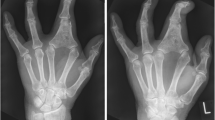Abstract
Polydactyly is one of the most common congenital deformities with an incidence of between 5 and 17 per 10,000 live births. Super-numerary digits of the foot present most commonly at the fibular border. A super-numerary digit arising from the dorsum of the foot has only been described on two occasions. In one case, the digit was thought to be a skin appendage. In the other, the digit shared morphological features with its neighbours but was relatively hypo-plastic and was incapable of active movement. The child was non-syndromic. We present a case of a mobile, active super-numerary digit arising from the dorsum of the foot, the first of its kind to be described in the literature. The child had the rare congenital disorder Kabuki syndrome.



Similar content being viewed by others
References
Blauth W, Olason AT (1988) Classification of polydactyly of the hands and feet. Arch Orthop Trauma Surg 107:334–344
Miura T, Nakamura R, Imamura T (1987) Polydactyly of the hands and feet. J Hand Surg 12(3):474–476
Zguricas J, Bakker WF, Heus H et al (1998) Genetics of limb development and congenital hand malformations. Plast Reconstr Surg 101(4):1126–1135
Castilla EE, Lugarinho R, de Graca Dutra M et al (1998) Associated anomalies in individuals with polydactyly. Am J Med Genet 80(5):459–465
Coppolelli BG, Ready JE, Awbrey BJ et al (1991) Polydactyly of the foot in adults: literature review and unusual case presentation with diagnostic and treatment recommendations. J Foot Surg 30(1):12–18
Fortems Y, De Smet L, Fabry G (1996) Extra digit at the dorsum of the foot: hypoplastic central ray metatarsal duplication. J Pediatr Orthop 5:132–133
Kitayama Y, Nawate K (1994) A case of polydactyly of the toe at the dorsal aspect of the foot. Jap J Plast Reconstr Surg 37(1):101–105
Tickle C (1987) Experimental embryology as applied to the upper limb. J Hand Surg 12:294–300
Beatty E (1985) Upper limb tissue differentiation in the human embryo. Hand Clin 1:391–403
Niikawa N, Matsuura N, Fukushima Y, Ohsawa T, Kajii T (1981) Kabuki make-up syndrome: a syndrome of mental retardation, unusual facies, large and protruding ears, and postnatal growth deficiency. J Pediatr 99:565
Kuroki Y, Suzuki Y, Chyo H, Hata A, Matsui I (1981) A new malformation syndrome of long palpebral fissures, large ears, depressed nasal tip, and skeletal anomalies associated with postnatal dwarfism and mental retardation. J Pediatr 99:565
Adam MP, Hudgins L (2005) Kabuki syndrome: a review. Clin Genet 67(3):209–219
Author information
Authors and Affiliations
Corresponding author
Rights and permissions
About this article
Cite this article
Hussain, M., Glass, G.E. & Moss, A.L.H. An actively mobile accessory digit arising from the dorsum of the foot: an unusual example of polydactyly. Eur J Plast Surg 29, 381–383 (2007). https://doi.org/10.1007/s00238-007-0114-1
Received:
Accepted:
Published:
Issue Date:
DOI: https://doi.org/10.1007/s00238-007-0114-1




